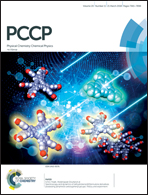Insights into the effect of donor ability on photophysical properties of dihydroindeno[2,1-c]fluorene-based imide derivatives†
Abstract
The photophysical properties of dihydroindeno[2,1-c]fluorene-based imide (DHIFI) derivatives were investigated by steady-state and time-resolved spectroscopy as well as quantum chemical calculations. The hybridized local excited and charge transfer state (HLCT) was introduced to interpret the intercrossing of localized excited (LE) and charge transfer (CT) states. The large extent of CT in the HLCT state of a molecule with a strong electron donor (dimethylaniline) at the terminal site results in strong interaction between the dipole moments of the excited state and polar solvents. Time-resolved spectroscopy results show the formation of a stabilized ICT state in several picoseconds, which results in fluorescence quenching and less possibility of intersystem crossing to the triplet state. In contrast, a molecule with a weak electron donor (benzene) displays less fluorescence quenching. The slowing down of geometry relaxation in the weak-electron-donor molecule increases the possibility of ISC to the triplet state from the unrelaxed HLCT state.
![Graphical abstract: Insights into the effect of donor ability on photophysical properties of dihydroindeno[2,1-c]fluorene-based imide derivatives](/en/Image/Get?imageInfo.ImageType=GA&imageInfo.ImageIdentifier.ManuscriptID=C7CP07985K&imageInfo.ImageIdentifier.Year=2018)


 Please wait while we load your content...
Please wait while we load your content...